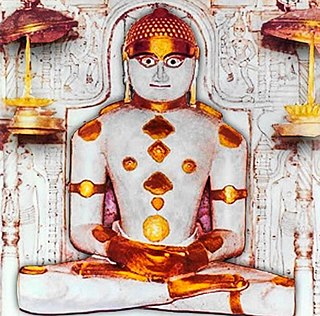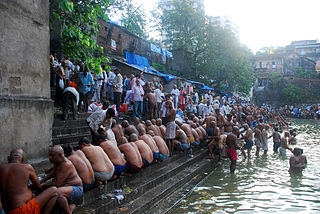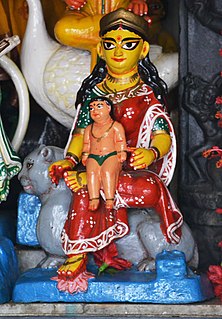The Hindu calendar, Panchanga or Panjika is one of various lunisolar calendars that are traditionally used in the Indian subcontinent and Southeast Asia, with further regional variations for social and Hindu religious purposes. They adopt a similar underlying concept for timekeeping based on sidereal year for solar cycle and adjustment of lunar cycles in every three years, but differ in their relative emphasis to moon cycle or the sun cycle and the names of months and when they consider the New Year to start. Of the various regional calendars, the most studied and known Hindu calendars are the Shalivahana Shaka found in the Deccan region of Southern India, Vikram Samvat (Bikrami) found in Nepal, North and Central regions of India – all of which emphasize the lunar cycle. Their new year starts in spring. In regions such as Tamil Nadu and Kerala, the solar cycle is emphasized and this is called the Tamil Calendar and Malayalam calendar and these have origins in the second half of the 1st millennium CE. A Hindu calendar is sometimes referred to as Panchangam (पञ्चाङ्ग), which is known also known as Panjika in Eastern India.
Hindu views of homosexuality, and LGBT issues more generally, are diverse and different Hindu groups have distinct views. A number of Hindu texts have portrayed homosexual experience as natural and joyful, the Kamasutra affirms and recognizes same-sex relations, and there are several Hindu temples which have carvings that depict both men and women engaging in homosexual acts. There are also numerous Hindu deities that are shown to be gender-fluid and falling into the LGBT spectrum. Same-sex relations and gender variance have been represented within Hinduism from Vedic times through to the present day, in rituals, law books, religious or narrative mythologies, commentaries, paintings, and even sculptures. In 2009, the Delhi High Court legalised homosexuality in India, but the Supreme Court of India subsequently overturned the high court's decision. The Supreme Court of India, in a later ruling in 2018, reversed its previous verdict and decriminalised homosexual intercourse and relationships.

Bhadra or Bhadrapada or Bhādo or Bhadraba is a month of the Hindu calendar that corresponds to August/September in the Gregorian calendar. In India's national civil calendar, Bhadra is the sixth month of the year, beginning on 23 August and ending on 22 September. In Vedic Jyotish, Bhadra begins with the Sun's entry into Leo, and is usually the fifth month of the year.
Vikram Samvat or Bikram Sambat and also known as the Vikrami calendar, is a historical Hindu calendar used in the Indian subcontinent. It is the official calendar of Nepal. In India, it is used in several states. The traditional Vikram Samvat calendar, as used in India, uses lunar months and solar sidereal years. The Nepali Bikram Sambat introduced in 1901 AD, also uses a solar sidereal year.

Teej is the generic name for a number of Hindu festivals that are celebrated by women. Haryali Teej and Hartalika Teej welcome the monsoon season and are celebrated primarily by girls and women, with songs, dancing and prayer rituals. The monsoon festivals of Teej are primarily dedicated to Parvati and her union with Shiva. Women often fast in celebration of Teej. Hartalika Teej is celebrated in all parts of Nepal and most of the parts of North India. Teej festivals are traditionally observed by women to celebrate the monsoons during the months of Shravan and Bhadrapada of Hindu calendar. Women often pray to Parvati and Shiva during Teej.

Rishabhanatha, also Ṛṣabhadeva, Rishabhadeva, Ṛṣabha or Ikshvaku is the first Tīrthaṅkara of Jainism and establisher of Ikshvaku dynasty. He was the first of twenty-four teachers in the present half-cycle of time in Jain cosmology, and called a "ford maker" because his teachings helped one across the sea of interminable rebirths and deaths. The legends depict him as having lived millions of years ago. He was the spiritual successor of Sampratti Bhagwan, the last Tirthankar of previous time cycle. He is also known as Ādinātha which translates into "First (Adi) Lord (nātha)", as well as Adishvara, Yugadideva, Prathamarajeshwara, and Nabheya. Along with Mahavira, Parshvanath, Neminath, and Shantinath; Rishabhanath is one of the five Tirthankaras that attract the most devotional worship among the Jains.
Akshaya Tritiya, also known as Akti or Akha Teej,is an annual Hindu and Jain spring festival. It falls on the third tithi of the bright half of the month of Vaisakha. It is regionally observed as an auspicious day by Hindus and Jains in India ,it signifies the "third day of unending prosperity".
Paksha , thwa and gа̄ in Nepal Bhasa, refers to a fortnight or a lunar phase in a month of the Hindu lunar calendar.
This article lists the traditional festivals and other cultural events in the Odisha region of India. Odisha celebrates 13 festivals in 12 months as the saying goes Bāra Māsare Tera Parba.

Pitru Paksha is a 16–lunar day period in Hindu calendar when Hindus pay homage to their ancestors (Pitrs), especially through food offerings. The period is also known as Pitri Paksha/Pitr-Paksha, Pitri Pokkho, Sorah Shraddha, Kanagat, Jitiya, Mahalaya, Apara Paksha and akhadpak, Pitru Pandharavda or pitru paksh.
Navami is the Sanskrit word for "nine", and is the ninth day in the lunar fortnight (Paksha) of the Hindu calendar. Each month has two Navami days, being the ninth day of the "bright" (Shukla) and of the "dark" (Krishna) fortnights respectively. Thus Navami occurs on the ninth and the twenty-fourth day of each month.

Shashthi or Shashti is a Hindu goddess, venerated in Nepal and India as the benefactor and protector of children. She is also the deity of vegetation and reproduction and is believed to bestow children and assist during childbirth. She is often pictured as a motherly figure, riding a cat and nursing one or more infants. She is symbolically represented in a variety of forms, including an earthenware pitcher, a banyan tree or part of it or a red stone beneath such a tree; outdoor spaces termed shashthitala are also consecrated for her worship. The worship of Shashthi is prescribed to occur on the sixth day of each lunar month of the Hindu calendar as well as on the sixth day after a child's birth. Barren women desiring to conceive and mothers seeking to ensure the protection of their children will worship Shashthi and request her blessings and aid. She is especially venerated in eastern India.
Prathama is the Sanskrit word for "first", and is the first day in the lunar fortnight (Paksha) of the Hindu calendar. Prathama is also known as Pratipada in West Bengal, Odisha and western India. Each month has two Prathama days, being the first day of the "bright" (Shukla) and of the "dark" (Krishna) fortnights respectively. Thus Prathama occurs on the first and the sixteenth day of each month. It is also known as Pratipad or Pratipada.
Dwitiya also referred to as Beej and Dooj is the Sanskrit word for "second", and is the second day in the lunar fortnight (Paksha) of the Hindu calendar. Each month has two Dwitiya days, being the second day of the "bright" (Shukla) and of the "dark" (Krishna) fortnights respectively. Thus Dwitiya occurs on the second and the seventeenth day of each month. Called as bidige in Kannada.
Dashami is the Sanskrit word for "ten", and is the tenth day in the lunar fortnight (Paksha) of the Hindu calendar. Each month has two Dashami days, being the tenth day of the "bright" (Shukla) and of the "dark" (Krishna) fortnights respectively. Thus Dashami occurs on the tenth and the twenty-fifth day of each month.
Trayodashi is the Sanskrit word for "thirteen", and is the thirteenth day in the lunar fortnight (Paksha) of the Hindu calendar. Each month has two Thrayodashi days, being the thirteenth day of the "bright" (Shukla) and of the "dark" (Krishna) fortnights respectively. Thus Thrayodashi occurs on the thirteenth and the twenty-eighth day of each month.
Here is a list of glossary of Culture of India in alphabetical order:
Jain festivals occur on designated days of the year. Jain festivals are either related to life events of Tirthankara or they are performed with intention of purification of soul.




